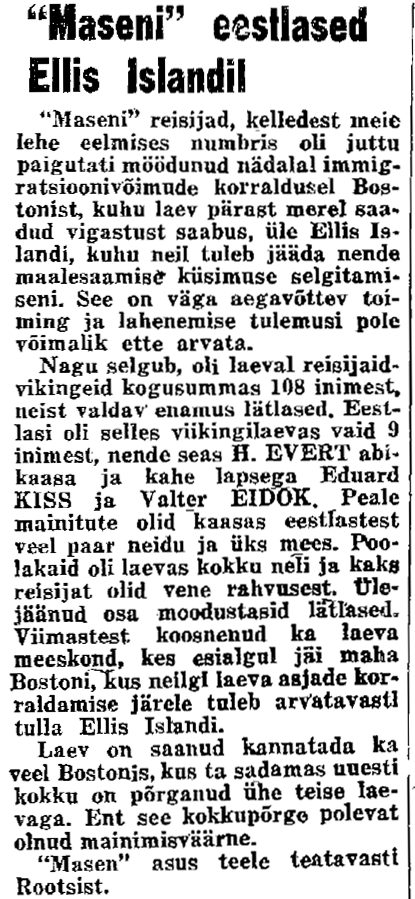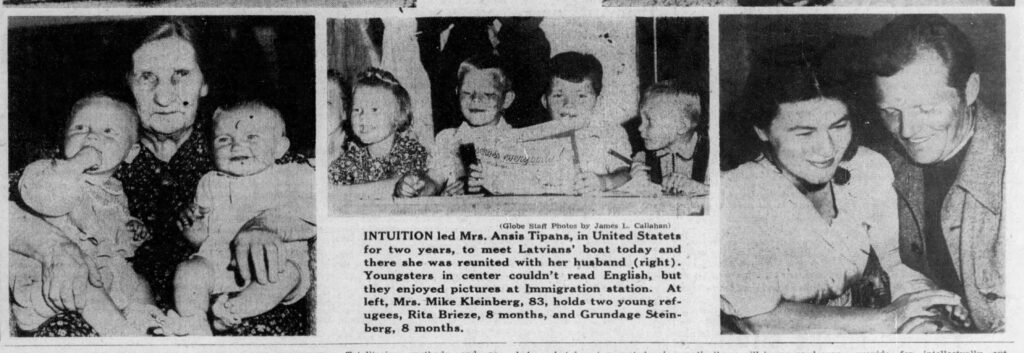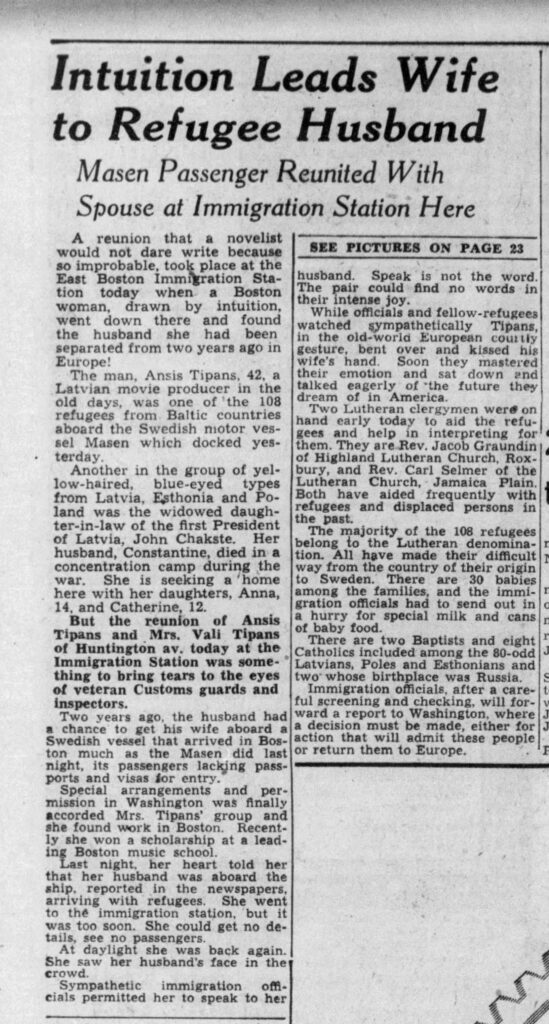Boats

Måsens ester på Ellis Island, Vaba Eesti Sõna, 9 september 1950.
MÅSEN
Klockan tre på natten den 4 augusti 1950 smög Måsen, en före detta brittisk minsvepare, ut ur hamnen i Falkenberg med över 100 flyktingar ombord. “Ännu en flyktingbåt lämnade Sverige i skydd av natten utan flagga, namn eller nödvändiga papper,” rapporterade Vaba Eesti Sõna den 19 augusti 1950. “Tulltjänstemän, polis och kustvakt var informerade, men oförmögna att stoppa båten i svenskt vatten.”
Yngve Johansson, överkonstapel i Falkenberg, beskriver båtens avfärd som en “semi-flykt” i Stockholms-Tidningen Eestlastele 6 augusti 1950. Detta eftersom den 32 meter långa Måsen hade förbjudits att segla fram tills ett sjövärdighetscertifikat utfärdats, vilket inte kunde göras på grund av det höga antalet passagerare ombord.
Majoriteten av flyktingarna ombord Måsen var letter, så även dess huvudägare. Enligt olika rapporter hade skeppet 108 passagerare, inklusive 27 småbarn och en 81-årig kvinna. Ombord fanns nio ester, fyra polacker och två ryssar. Valja Tipans, som hade anlänt ombord Gundel två år tidigare, hade en misstanke om att hennes man, Ansis Tipans, kunde vara en passagerare ombord, och tog sig därför till East Bostons Immigration Station dit flyktingarna hade tagits. Boston Globe rapporterade om deras lyckliga återförening (se bild nedan). Ombord fanns även Anastasia Čakste, svärdotter till Lettlands första president, Jānis Čakste. Hennes man, Konstantin Čakste hade varit medlem i den lettiska motståndsrörelsen och dödats av tyskarna 1945.
Båtens rutt är okänd men nyhetstidningar rapporterade att dess ursprungliga destination var Puerto Cabello i Venezuela.

Boston Globe rapporterade om Måsens kollision med ett skepp i hamnen i Boston. Båten hade redan krockat med Waymouth i tung dimma ute på Atlanten. 30 augusti 1950.
Den 28 augusti 1950, i tät dimma, kolliderade Måsen med fiskebåten Waymouth, 180 sjömil utanför den nordöst-amerikanska kusten. Ingen människa kom till skada, men flyktingskeppet däremot skadades ovanför vattenlinjen. Båten bogserades till Boston, vilket tog två dagar. När det la till i hamnen krockade det igen. Efter landstigning skickades flyktingarna till Ellis Island eftersom de saknade visum, där de hölls i nästan fem månader innan de släpptes mot borgen.
Kända besättningsmän och passagerare:
- H. Evert, fru och två barn
- Eduard Kiss
- Valter Eidok
- Ansis Tipans
- Anastasia Čakste, med barnen Anna, 14 och Katrina, 12
- Rita Brieze, 8 månader
- Grundage Steinberg, 8 månader

Dagens Nyheter publicerade bilder av balterna ombord Måsen, samt visade den skadade båten efter att den kolliderat med Waymouth utanför USA:s kust.

Valja Tipans, som anlände ombord Gundel 1948 hade en misstanke att hennes man, Ansis skulle vara ombord Måsen. Boston Globe dokumenterade deras lyckliga återförening (längst till höger). 30 augusti 1950.

